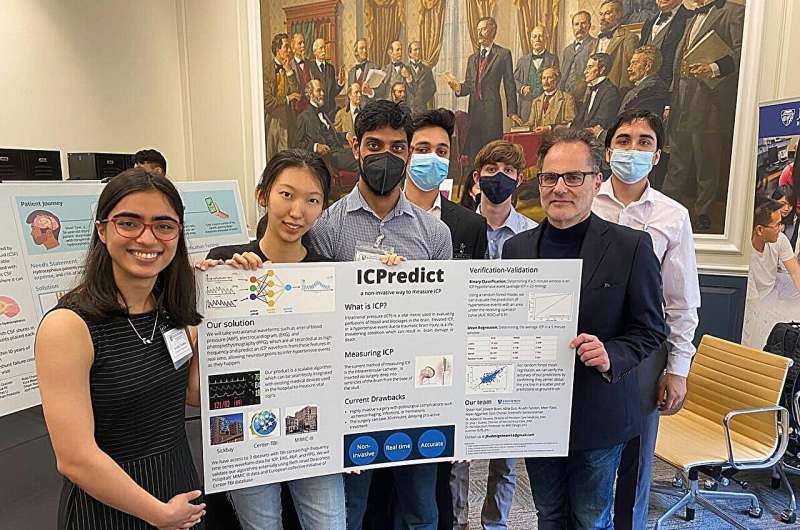This article has been reviewed according to Science X's editorial process and policies. Editors have highlighted the following attributes while ensuring the content's credibility:
fact-checked
trusted source
proofread
AI could change the way we measure brain pressure in neurocritical patients

A Johns Hopkins University research team has developed an algorithm to non-invasively measure intracranial pressure (ICP) using vital sign data routinely checked in the ICU.
The new method leverages deep learning techniques to generate ICP measurements with an accuracy comparable to the current gold-standard approach, which requires drilling through the skull.
"Non-invasive ICP measurement is something of a holy grail in intensive care medicine. This new method could be a game changer because we could potentially offer the ability to obtain ICP measurements without performing this extremely invasive procedure," said senior author Robert Stevens, an associate professor of anesthesiology and critical care medicine at Johns Hopkins University School of Medicine.
The research team—which includes biomedical engineering students and faculty, anesthesiologists, and neurosurgeons—published their findings in the July issue of Computers in Biology and Medicine.
Learning to innovate with artificial intelligence
As an intensive care physician, Stevens treats patients with acute brain trauma, a condition that can lead to brain swelling and a potentially fatal increase in pressure inside the patient's skull.
Currently, the most effective way to monitor ICP is to drill a hole in the skull and advance a catheter into the brain tissue to collect waveform information—a high-risk procedure that requires a surgical team and can only be performed in an intensive care unit, operating room, or emergency department. There are other non-invasive methods for measuring ICP, but few have demonstrated reliability, and most can't generate continuous ICP measurements.
Three years ago, Stevens challenged students in the Department of Biomedical Engineering's Undergraduate Design Team program to use AI to help clinicians accurately and continuously monitor ICP without surgery.
"Our team brought a wide variety of experience to the project, from strong data science and programming skills to prototyping expertise," said Shiker Nair, Engr '22, the study's first author and leader of the Design Team ICPredict. "But our biggest challenge was balancing technical feasibility with clinical impact. In the scope of just one year, what could we possibly do that would make a definitive change in the current landscape of ICP monitoring?"
The students shadowed clinicians and neurologists in the Neuro-ICU at Johns Hopkins Hospital, getting a first-hand look at the importance of ICP monitoring and the major limitations they needed to address. Nair said that while they explored many possible solutions addressing various aspects of the problem, the process of integrating these solutions was challenging.
Eventually, under the guidance of Stevens and Nicholas Durr, an associate professor of biomedical engineering, the students developed an AI algorithm designed to indirectly calculate ICP by analyzing the waveform patterns of physiologic variables which are more readily accessible, such as arterial blood pressure.
Testing the algorithm
To build and test their approach's predictive abilities, the team studied three sources of waveform data that are continuously collected from ICU patients: arterial blood pressure (ABP), electrocardiogram (ECG), and photoplethysmography (the signal used for pulse oximetry recordings).
They started with a dataset of patients who had simultaneous measurements taken of these variables and invasive ICP measurements obtained via catheters in the brain. Next, they used ABP, ECG, and PPG waveforms to train six different deep-learning algorithms to see if they could generate ICP waveforms that were accurate when compared to the "ground truth" ICP measured using invasive methods.
It worked. The ICP values estimated using the new algorithm closely matched those measured using invasive methods. What's more, the Hopkins algorithm was as accurate as, or even more accurate than, other non-invasive methods for evaluating ICP.
These results are quite significant, according to Stevens, who points out that a method that allows for continuous, real-time non-invasive ICP monitoring could spare patients from a risky surgery and let physicians know when they must intervene to decrease ICP.
"If further studies confirm that this is reliable and accurate, maybe we can do away with the invasive ICP monitoring altogether," Stevens said. "What's also exciting is that this would mean ICP could be monitored in various care settings, and not just in an intensive care unit."
The team plans to validate these findings using a much larger dataset before moving on to enrolling a cohort of patients for a prospective trial. Many of the students, including Nair, have continued to work on the project even after moving on to other institutions or industry positions.
"It's been remarkable to see how something that started as a class project ended up here. It's a testament to the motivation and engagement of our students that we've arrived at a result that is, in many ways, a great success," Stevens said.
More information: Shiker S. Nair et al, A deep learning approach for generating intracranial pressure waveforms from extracranial signals routinely measured in the intensive care unit, Computers in Biology and Medicine (2024). DOI: 10.1016/j.compbiomed.2024.108677



















